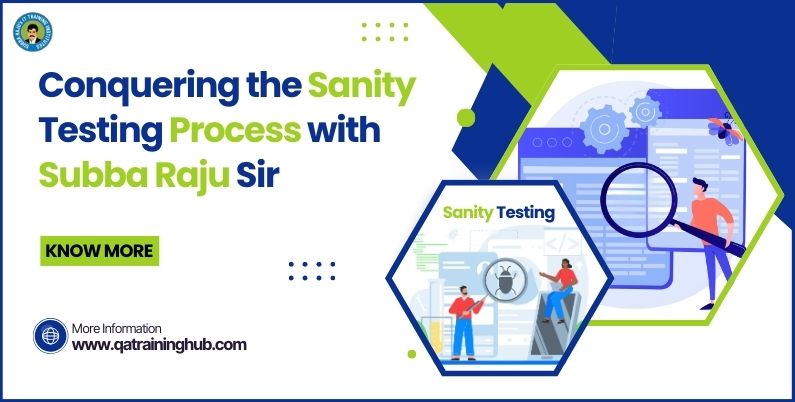
Sanity testing is an integral part of the software quality assurance process, ensuring that new changes or bug fixes do not disrupt existing functionality. As a focused form of regression testing, it plays a pivotal role in maintaining software stability during development cycles. In this blog, Subba Raju Sir, an expert from QA Training Hub, shares his insights on conquering the sanity testing process with best practices that ensure efficient and effective testing. Sanity testing is a critical yet often overlooked phase in software quality assurance. It ensures that the core functionality of an application remains intact after minor changes or bug fixes. In this blog, we delve into the intricacies of sanity testing with the guidance of Subba Raju Sir, a seasoned expert in QA. “Conquering the Sanity Testing Process with Subba Raju Sir” provides invaluable insights into streamlining your sanity tests, improving efficiency, and delivering high-quality software products.
Understanding Sanity Testing with Subba Raju Sir
Sanity testing is designed to validate the logic of newly implemented functionalities or fixes without delving into comprehensive testing. Unlike smoke testing, which is broader, sanity testing zeroes in on particular areas that have been modified, ensuring that these changes do not introduce new issues. Subba Raju Sir emphasizes that sanity testing acts as a quality checkpoint, allowing testers to verify that the core functionality remains intact before moving on to more exhaustive testing phases.
Benefits of Sanity Testing:
Sanity testing offers several benefits that help ensure software quality and maintain a smooth development workflow. Here are the key benefits of sanity testing:
1. Quick Validation of Changes
Sanity testing provides a fast and efficient way to validate specific changes, such as bug fixes or new features, without conducting exhaustive tests. This quick check ensures that recent modifications work as intended without causing major disruptions.
2. Saves Time and Resources
By focusing only on the affected areas of the application, sanity testing saves significant time and resources compared to more comprehensive testing methods. This efficiency allows the QA team to keep up with rapid development cycles.
3. Early Detection of Critical Issues
Sanity testing helps identify critical issues early in the development process, reducing the likelihood of severe bugs making it into production. Early detection minimizes the risk of costly fixes later in the development cycle.
4. Ensures Stability of Core Features
Even minor changes can sometimes disrupt core functionalities. Sanity testing ensures that critical features remain stable after updates, maintaining the overall integrity of the application.
5. Acts as a Gatekeeper for Further Testing
Sanity testing acts as a preliminary check before more exhaustive testing phases, such as regression testing. This gatekeeping role ensures that only stable builds proceed to the next testing stage, improving the overall efficiency of the QA process.
6. Reduces Testing Overhead
By targeting only the modified components, sanity testing reduces unnecessary testing overhead. This targeted approach allows QA teams to focus their efforts on areas that matter most, optimizing the overall testing workload.
7. Facilitates Faster Release Cycles 
In Agile and DevOps environments, speed is essential. Sanity testing helps teams meet tight release deadlines by quickly verifying that changes are functioning correctly, enabling faster release cycles without compromising quality.
8. Improves Communication with Developers
Sanity testing fosters better communication between testers and developers. By pinpointing specific issues related to recent changes, testers can provide clear and actionable feedback to developers, streamlining the debugging and fixing process.
9. Enhances Customer Satisfaction
Ensuring that software updates do not introduce new issues leads to more reliable software, enhancing the end-user experience. Sanity testing helps maintain application quality, which ultimately boosts customer satisfaction and trust.
10. Supports Continuous Integration and Continuous Delivery (CI/CD)
Sanity testing is well-suited for CI/CD pipelines, where frequent code changes and updates are the norm. Its quick turnaround helps maintain the continuous flow of software updates while ensuring stability, supporting the principles of CI/CD.By integrating sanity testing into your QA strategy, you can enhance the efficiency and effectiveness of your testing process, leading to more stable and reliable software products.
Sanity Testing vs. Smoke Testing: Key Differences by Subba Raju Sir
Subba Raju Sir explains the common confusion between sanity and smoke testing:
Smoke Testing: A broad, shallow approach that verifies basic functionalities to ensure the build is stable enough for further testing.
Sanity Testing: A targeted, deep approach focusing on specific functionalities or bug fixes to confirm that the changes are correct and do not break other parts of the application.
Understanding these distinctions allows QA professionals to apply the right testing method at the right time, ensuring optimal results.
Sanity Testing Process Flow
- Requirement Analysis: Identify the critical functionalities or modules that have undergone recent changes or fixes. Understand the purpose of the change to target specific areas for sanity testing.
- Test Case Selection: Choose a small subset of high-priority test cases related to the modified functionalities. Focus on key features without diving into exhaustive testing.
- Environment Setup: Ensure the test environment is ready and matches the required configurations. Confirm that the latest build or software version containing the recent fixes is deployed.
- Execution of Sanity Tests: Execute the selected test cases manually or using automation tools. Focus on the areas directly impacted by the changes to validate their functionality.
- Result Analysis: Analyze the test results to check whether the critical functionality is working as expected. If the sanity tests pass, continue with further testing (e.g., regression testing). If the sanity tests fail, log defects and send the build back for fixes.
- Defect Logging: Record any defects encountered during sanity testing in a defect tracking tool. Categorize the defects based on their severity and impact.
- Reporting and Decision Making: Generate a summary report of the sanity testing outcome. Decide whether to proceed with further testing (if successful) or stop and send the build for rework (if unsuccessful).
- Test Closure: If sanity testing is successful, prepare for a more thorough round of testing. Document the results and close the testing phase for the sanity check.
This process ensures that the system’s most important features are working after changes, allowing for further detailed testing.
Best Practices for Effective Sanity Testing:
Subba Raju Sir, a distinguished trainer at QA Training Hub, offers these best practices to help you conquer the sanity testing process:
Keep It Focused: Sanity testing should remain quick and targeted. Focus on the most critical areas impacted by the changes to ensure a swift verification process.
Automate When Possible: Automation tools can significantly speed up the sanity testing process, especially for repetitive tasks. Subba Raju Sir recommends using automation for frequently tested functionalities.
Maintain Up-to-Date Test Cases: Regularly update your test cases to reflect changes in the application. This practice ensures that tests remain relevant and effective, reducing the risk of overlooking critical issues.
Collaborate with Developers: Close collaboration with developers helps testers understand the changes better, allowing for more precise and effective sanity testing.
Document Findings: Keeping detailed records of your testing process and outcomes is invaluable for future reference. Documentation aids in improving the overall QA process, providing insights into what works and what doesn’t.
Learning from Subba Raju Sir at QA Training Hub:
Sanity testing might seem like a minor component of the testing process, but its impact on maintaining software stability is profound. Under the expert guidance of Subba Raju Sir at QA Training Hub, you can master the skills needed to perform effective sanity testing, enhancing the overall quality of your software projects. His practical advice and real-world examples make sanity testing not just a task but a critical part of the QA journey.
About QA Training Hub and Subba Raju Sir:
QA Training Hub is a leading institution dedicated to equipping QA professionals with the skills needed to excel in software testing. With years of experience, Subba Raju Sir brings invaluable insights into various testing processes, including sanity testing. His unique approach to teaching focuses on practical knowledge, making complex concepts accessible and actionable for learners at all levels.
Conclusion
Conquering the Sanity Testing Process with Subba Raju Sir requires a focused approach, collaboration, and adherence to best practices. With guidance from experts like Subba Raju Sir, you can streamline your sanity testing efforts, ensuring that your software remains stable and reliable. Whether you are a seasoned tester or new to the field, mastering sanity testing will empower you to contribute more effectively to your team’s success. Start your journey towards mastering sanity testing with QA Training Hub and learn from the best in the field.
In the rapidly evolving world of software development, ensuring stability and quality is non-negotiable. By “Conquering the Sanity Testing Process with Subba Raju Sir,” testers gain a clear roadmap to efficiently validate software functionality after updates. His practical approach, combined with real-world insights, simplifies the sanity testing process, allowing QA teams to focus on what truly matters—delivering bug-free, user-friendly software.
For those looking to elevate their skills in software testing, QA Training Hub provides expert guidance and comprehensive training. With industry-focused courses and mentorship from professionals like Subba Raju Sir, QA Training Hub helps you stay ahead in your QA career. Embrace this opportunity to enhance your testing capabilities and ensure your software meets the highest standards of quality and performance.
FAQ:
- What is sanity testing?
A: Sanity testing is a subset of regression testing focused on verifying that the basic functionalities of a software application work as expected after minor changes or bug fixes. It ensures that no new issues were introduced before proceeding with further testing.
- Why is sanity testing important?
A: Sanity testing is crucial as it helps testers quickly identify if critical functionalities are operational after changes. It saves time by confirming that the build is stable enough for more in-depth testing.
- Who should perform sanity testing?
A: Sanity testing is typically performed by testers, but developers may also conduct initial sanity checks before handing the build to the QA team.
- What distinguishes sanity testing from smoke testing?
A: While both sanity and smoke testing verify software builds, sanity testing focuses on a specific area of functionality after modifications, while smoke testing checks the overall stability of the build before deeper testing.
- How does Subba Raju Sir approach sanity testing?
A: Subba Raju Sir emphasizes a structured approach to sanity testing that includes clear identification of critical areas, effective test case creation, and rigorous validation of essential features.
- What are the key components of a sanity test suite?
A: A sanity test suite includes test cases targeting critical functionalities, recently fixed bugs, and areas likely impacted by recent changes in the build.
- How often should sanity testing be conducted?
A: Sanity testing should be performed whenever there are minor changes, bug fixes, or enhancements to the software. It ensures the integrity of the application before moving to further testing phases.
- What tools are recommended for sanity testing?
A: Subba Raju Sir suggests using popular automation tools like Selenium, JUnit, or TestNG for repetitive sanity tests, depending on the project’s needs and complexity.
- Can sanity testing be automated?
A: Yes, sanity testing can be automated to save time and resources. However, it requires well-defined test cases that can be reused across different builds.
- What common challenges are faced during sanity testing, and how can they be addressed?
A: Challenges include unclear test objectives, missing test cases, or incomplete fixes. Subba Raju Sir advises clear documentation, regular communication between developers and testers, and a well-maintained test suite to overcome these issues.








